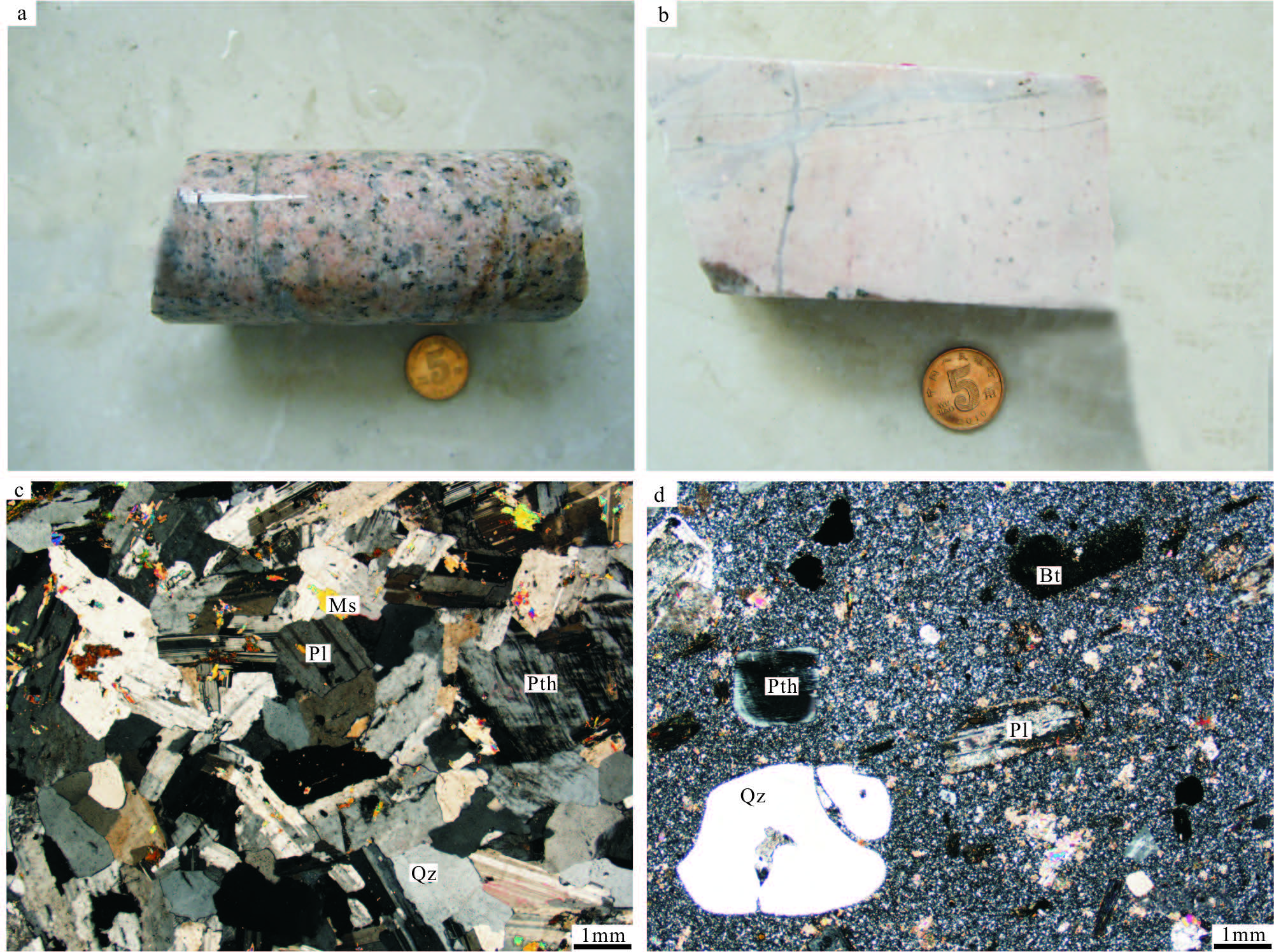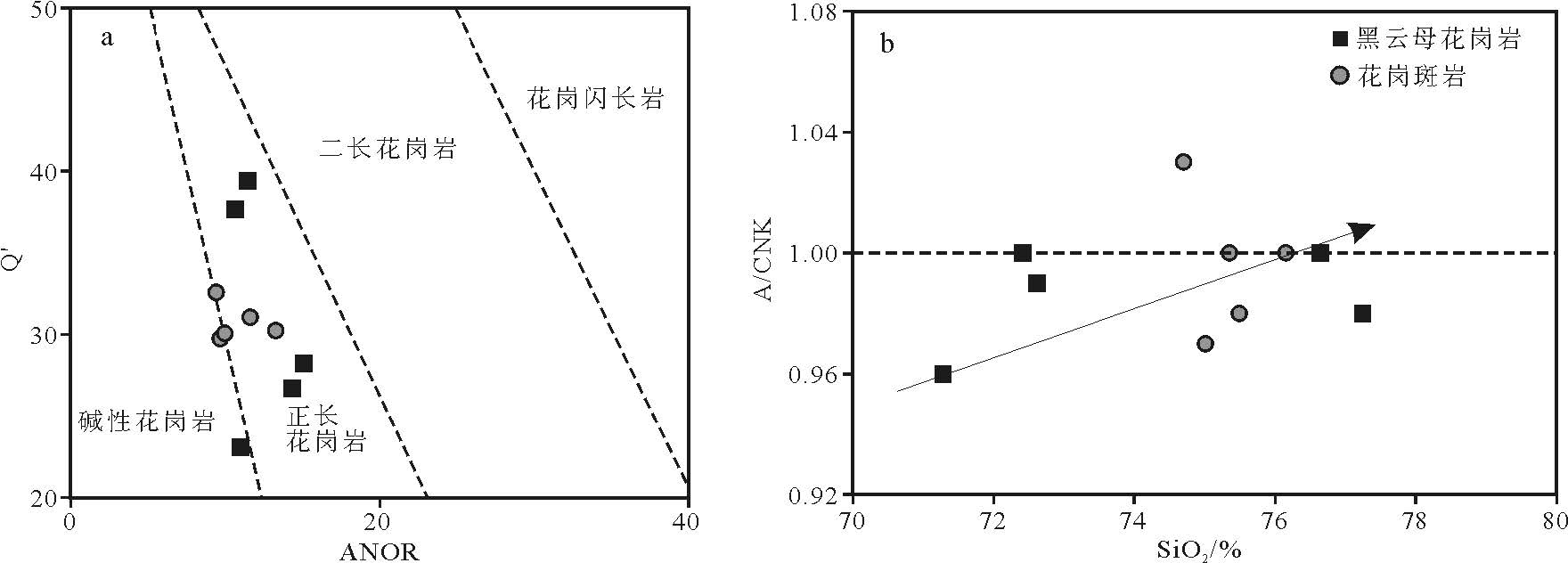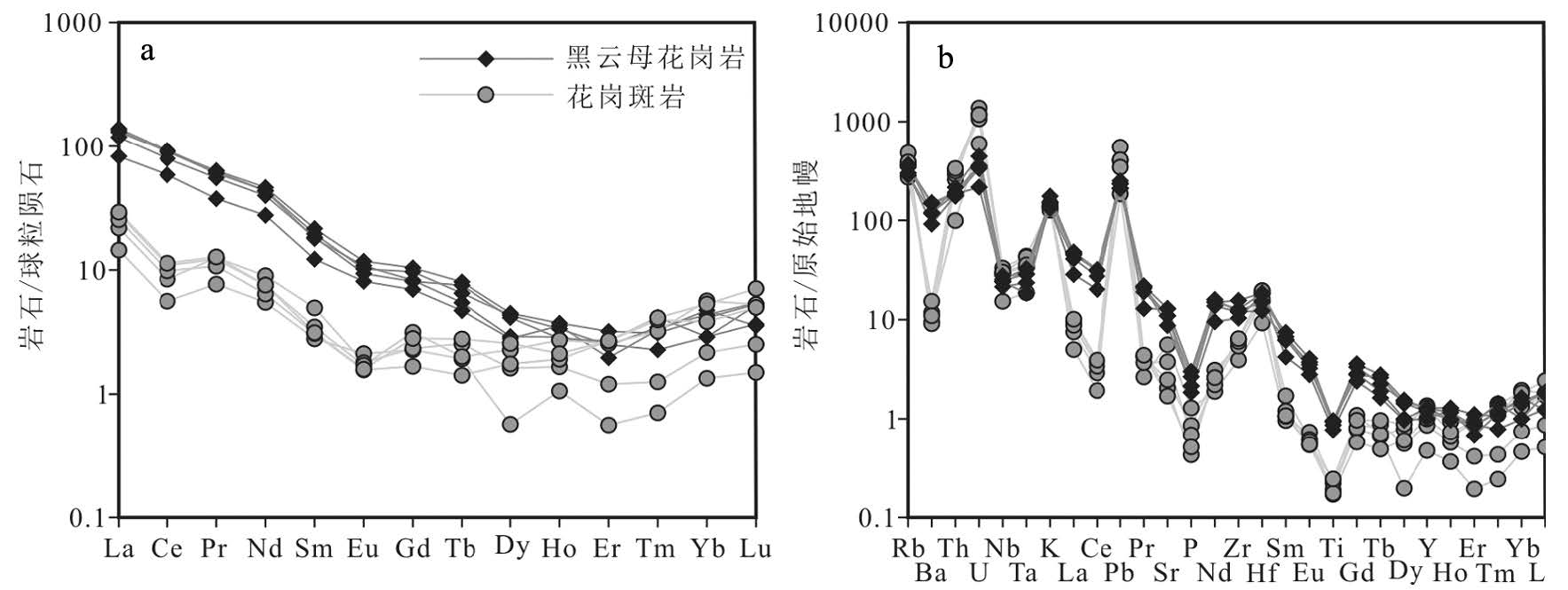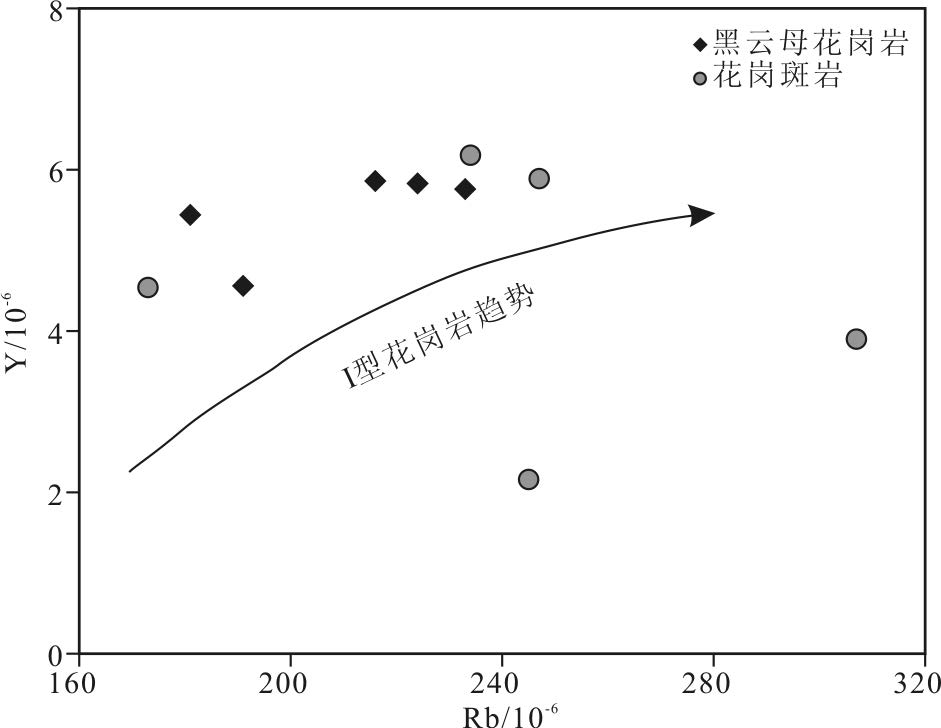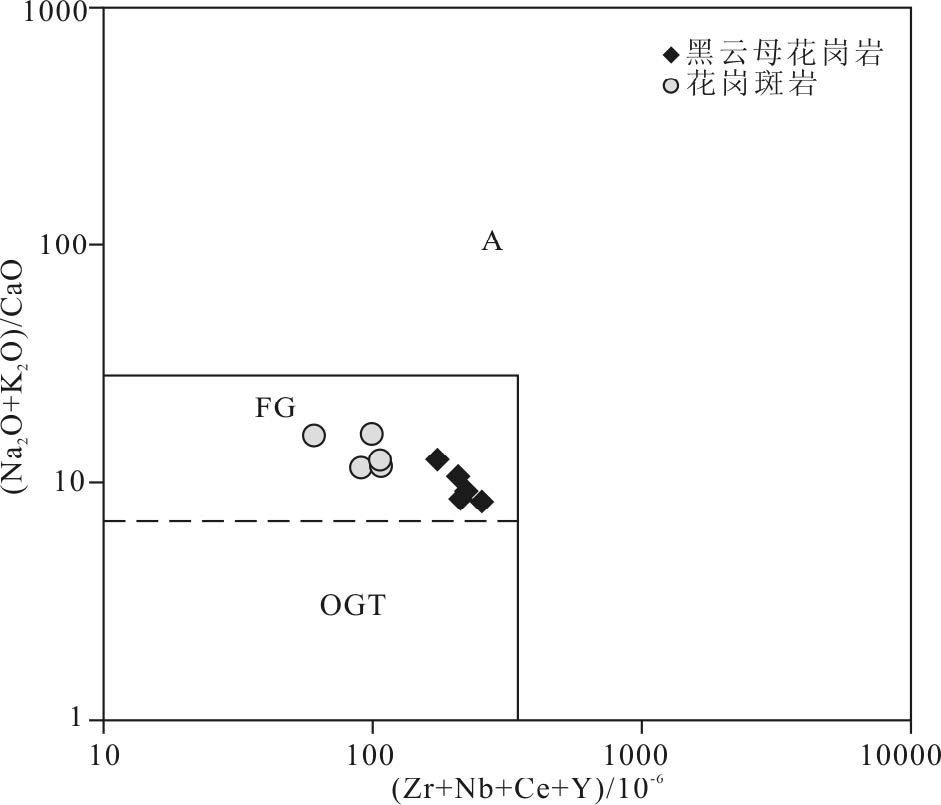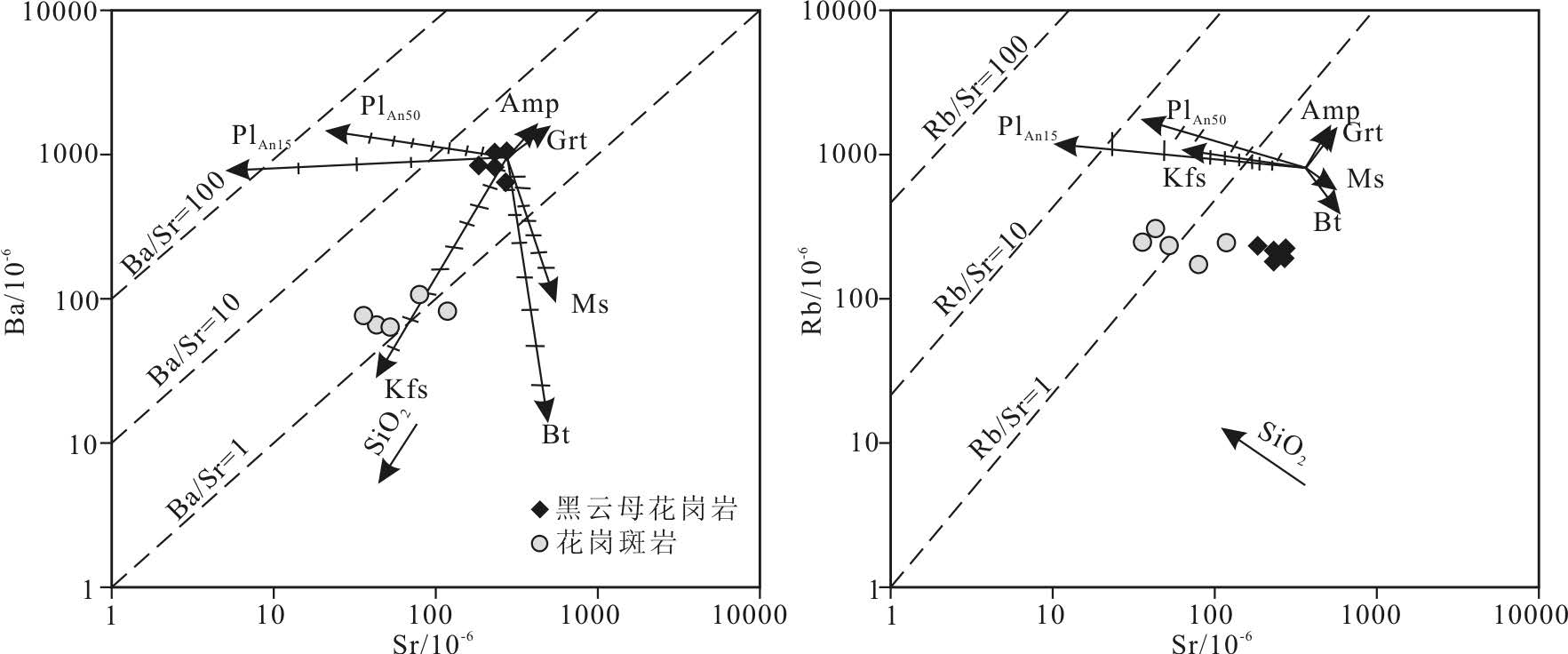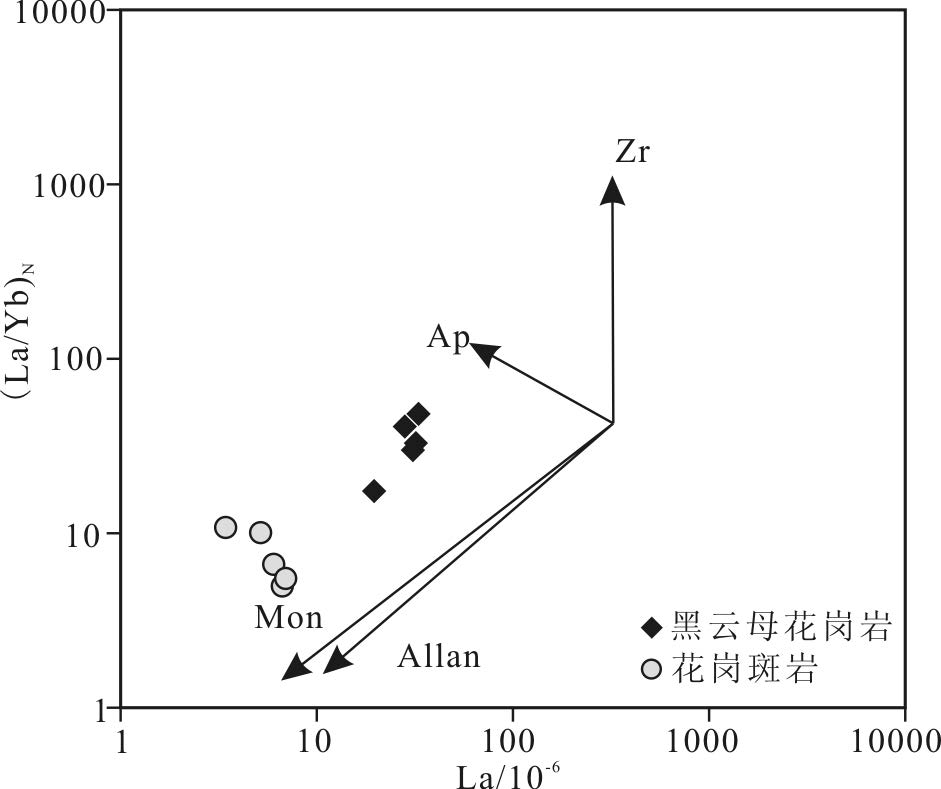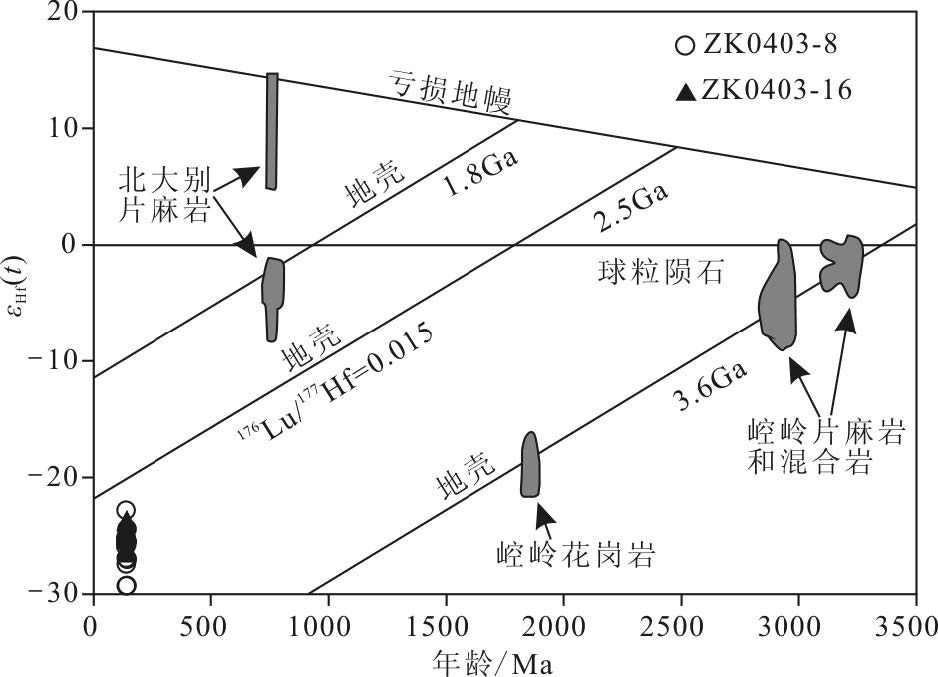Geochemistry of the Yaochong granite in Dabie orogenic belt and its geological implications
-
摘要:
姚冲岩体位于秦岭-大别山造山带上,岩体的主要岩性为黑云母花岗岩和花岗斑岩。岩石地球化学分析结果显示,姚冲岩体SiO2含量为71.28%~77.24%,K2O含量为3.81%~5.28%,Na2O含量为3.76%~5.03%,Al2O3含量为11.61%~14.6%,具有高钾钙碱性和准铝质-过铝质 (A/CNK=0.96~1.03) 特征。岩石稀土元素总量较低 (11.82×10-6~123.65×10-6),轻稀土元素相对富集,重稀土元素相对亏损,具有Eu负异常,岩体富集Rb、U、Hf和Y,亏损Ba、Nb、Ta和Ti,显示出I型花岗岩的特点。锆石Hf同位素分析结果表明,姚冲岩体的εHf(t) 值为-30~-22.8,位于地幔演化线之下,tDM2值变化于2.21~2.60Ga之间,指示其源于扬子板块北缘的古老地壳,其组成类似于扬子板块北缘TTG型岩浆岩。结合区域地质背景,姚冲岩体形成于扬子陆块与华北陆块碰撞造山后的陆内伸展环境,对应的地球动力学背景为晚侏罗世—早白垩世地壳从挤压收缩向区域性伸展的构造体制大转换过程。
Abstract:Located in the Qinling-Dabie orogenic belt, the Yaochong granite body mainly consists of biotite granite and granite porphyry. According to the geochemical analysis, Yaochong granites have the following data: SiO2=71.28%~77.24%, K2O=3.81%~5.28%, Na2O=3.76%~5.03%, Al2O3=11.61%~14.6%, and A/CNK=0.96~1.03. The rocks are enriched in LREE, depleted in HREE with negative Eu anomalies, enriched in Rb, U, Hf, Y and depleted in Ba, Nb, Ta, Ti, which indicates that Yaochong granites belong to metaluminous to peraluminous, high-K calc-alkaline I-type granite. According to zircon Hf isotope analysis, the εHf(t) values of the granite range from-30 to-22.8, lying below the depleted mantle line. The tDM2 values range from 2.21Ga to 2.60Ga, which indicates that the granite resulted from the lower crust of Yangtze block. The components of the granite porphyry are similar to those of Neoproterozoic TTG magmatic rocks. Yaochong granites were emplaced after the major collisional period of the North China block and Yangtze block, in a post-collisional tectonic setting under the regional extension mechanism. The geodynamic setting was the transformation of the tectonic regime of the late Jurassic-Early Cretaceous period.
-
Key words:
- Dabie /
- Yaochong /
- granite /
- geochemistry /
- geological implications
-

-
图 1 大别造山带地质略图 (据参考文献[13]修改)
Figure 1.
图 2 大别山北麓姚冲钼矿区地质略图 (据参考文献[6]修改)
Figure 2.
图 4 姚冲花岗岩ANOR-Q′标准化矿物图解 (a, 据参考文献[19]) 和SiO2-A/CNK图解 (b)(Q′=100×Q/(Q+Or+Ab+An);ANOR=100×An/(Or+An))
Figure 4.
图 7 姚冲花岗岩Rb-Y图解 (底图据参考文献[27])
Figure 7.
图 8 姚冲花岗岩(Zr+Nb+Ce+Y)-(Na2O+K2O)/CaO图解(底图据参考文献[32])
Figure 8.
图 9 姚冲花岗岩100*(TFeO+MgO+TiO2)/SiO2-(Al2O3+CaO)/(Na2O+K2O+TFeO) 图解(底图据参考文献[33])
Figure 9.
图 10 姚冲花岗岩造岩矿物结晶分异判别图解(底图据参考文献[35])
Figure 10.
表 1 姚冲矿区花岗岩主量、微量和稀土元素分析结果
Table 1. Major, trace and rare earth elements composition of Yaochong granites
样品号岩性 ZK0403-1 ZK0403-2 ZK0403-4 ZK0403-8 ZK0403-19 ZK0403-16 ZK0403-27 ZK0403-30 ZK0403-33 ZK0403-38 黑云母花岗岩 花岗斑岩 SiO2 76.64 77.24 71.28 72.41 72.61 76.15 75.35 75.01 75.49 74.70 TiO2 0.17 0.20 0.20 0.19 0.21 0.04 0.05 0.04 0.04 0.05 Al2O3 11.97 11.61 14.60 14.34 13.81 13.00 13.67 13.41 13.41 13.87 Fe2O3 1.09 1.17 1.22 1.08 1.25 0.31 0.42 0.51 0.57 0.54 FeO 0.39 0.48 0.43 0.41 0.49 0.46 0.30 0.46 0.22 0.33 MnO 0.03 0.04 0.03 0.03 0.05 0.00 0.02 0.01 0.03 0.03 MgO 0.23 0.32 0.27 0.38 0.45 0.25 0.10 0.16 0.07 0.08 CaO 0.64 0.73 1.15 0.99 1.07 0.55 0.71 0.77 0.77 0.58 Na2O 3.89 3.76 4.54 4.57 4.32 4.53 5.03 4.83 4.71 4.70 K2O 4.12 3.98 5.28 4.57 4.57 4.23 3.81 4.13 4.14 4.39 P2O5 0.04 0.05 0.07 0.06 0.05 0.02 0.01 0.02 0.01 0.03 LOI 0.71 0.62 1.08 0.94 1.10 0.48 0.53 0.68 0.49 0.78 Total 99.92 100.20 100.16 99.99 99.99 100.01 99.99 100.02 99.96 100.08 TFeO 1.37 1.53 1.38 1.53 1.61 0.74 0.68 0.92 0.74 0.82 A/CNK 1.00 0.98 1.00 0.96 0.99 1.00 1.00 0.97 0.98 1.03 ANK 1.10 1.11 1.15 1.11 1.15 1.08 1.10 1.08 1.10 1.11 Mg# 23.1 27.0 32.6 24.0 33.3 37.4 20.2 23.3 14.7 15.3 DI 94 94 92 93 92 95 96 95 95 95 Q 36.65 38.13 22.24 25.84 27.22 32.02 29.89 29.46 30.62 29.25 An 2.93 3.06 3.90 4.57 4.85 2.62 3.47 2.73 3.24 2.81 Ab 33.19 31.96 38.80 39.06 36.98 38.51 42.79 41.15 40.08 40.06 Or 24.55 23.63 31.51 27.28 27.32 25.11 22.64 24.57 24.60 26.14 C 0.05 - 0.22 - - 0.01 0.01 - - 0.37 Sc 5.35 4.97 5.62 5.47 6.46 3.39 6.09 6.23 3.99 2.74 V 21.3 16.5 20.9 14.7 18.7 10.2 7.89 12.7 5.69 5.29 Cr 7.01 3.45 5.23 1.07 2.21 2.15 0.26 2.19 0.34 0.05 Co 1.14 1.16 1.10 1.13 1.01 0.22 0.12 0.45 0.23 0.15 Ni 3.90 2.87 2.56 1.50 2.22 3.70 0.69 1.84 0.38 0.10 Ga 20.1 21.1 26.5 24.6 24 20.5 22.3 21.2 25.7 20 Rb 191 181 216 224 233 173 247 234 307 245 Sr 270 231 231 274 184 79.4 35.8 52.3 43.1 118 Y 4.56 5.44 5.86 5.83 5.76 4.54 5.89 6.18 3.9 2.16 Zr 116 134 143 136 175 67.6 72.1 70.9 60.6 44 Nb 17.5 19.7 18.2 15.3 17.1 21 21.5 23.6 20.8 10.9 Cs 2.45 2.13 2.7 2.5 2.72 1.63 4.2 10.9 2.71 2.41 Ba 642 818 1033 1053 840 107 76.5 63.7 65.9 82.1 La 19.6 28.1 30.9 32 33 6.03 6.94 6.67 5.17 3.43 Ce 35.9 48.6 55.8 54.8 56.6 6.03 6.94 6.67 5.17 3.43 Pr 3.57 5.26 5.72 6.03 5.93 1.02 1.21 1.16 1.19 0.73 Nd 12.9 18.6 20.4 21.6 20.3 2.99 3.53 3.53 4.2 2.56 Sm 1.87 2.81 2.99 3.30 2.74 0.47 0.48 0.53 0.76 0.43 Eu 0.47 0.54 0.59 0.68 0.63 0.09 0.09 0.10 0.10 0.12 Gd 1.43 1.66 1.99 2.14 1.70 0.34 0.58 0.65 0.48 0.47 Tb 0.18 0.28 0.24 0.30 0.20 0.05 0.10 0.08 0.10 0.07 Dy 0.71 1.05 1.10 1.14 0.74 0.45 0.65 0.58 0.41 0.15 Ho 0.20 0.16 0.19 0.21 0.16 0.11 0.12 0.15 0.09 0.06 Er 0.33 0.44 0.41 0.53 0.42 0.44 0.45 0.42 0.20 0.09 Tm 0.08 0.11 0.09 0.08 0.06 0.10 0.11 0.08 0.03 0.02 Yb 0.81 0.49 0.74 0.70 0.49 0.65 0.90 0.96 0.37 0.23 Lu 0.09 0.09 0.14 0.14 0.13 0.13 0.18 0.13 0.06 0.04 Hf 5.51 3.8 5.67 4.68 5.73 6.03 5.06 6.05 4.76 2.86 Ta 1.19 1.17 1.34 0.97 0.76 1.75 1.46 1.79 1.39 0.77 Pb 46.3 38.8 43.6 42.9 39 34.2 63.8 75.7 102 73.9 Th 15.2 18.3 16.3 14.9 15.6 26.8 28.5 24.8 21.9 8.46 U 7.26 9.33 7.5 7.02 4.55 22.4 24.7 24.9 28.9 12.5 Nb/Ta 14.71 16.84 13.58 15.85 22.56 12.00 14.73 13.18 14.96 14.23 Zr/Hf 21.05 35.26 25.22 29.06 30.54 11.21 14.25 11.72 12.73 15.38 ∑REE 78.13 108.20 121.30 123.65 123.10 18.91 22.28 21.71 18.34 11.82 LREE/HREE 19.43 24.24 23.77 22.62 30.55 7.31 6.22 6.11 9.51 9.55 (La/Yb)N 17.45 40.90 29.97 32.85 48.33 6.64 5.51 4.99 10.08 10.80 δEu=Eu/Eu* 0.84 0.71 0.70 0.74 0.83 0.66 0.53 0.52 0.49 0.84 TZr/℃ 804 816 820 811 838 757 762 759 747 723 注: N=球粒陨石标准化, 标准化值据参考文献[20]; A/CNK=molarAl/(Ca+Na+K); A/NK=molarAl/( Na+K); Mg#=100∗molarMg/(Mg+TFe2+); δEu=Eu/Eu∗=2EuN/(SmN+GdN); TZr=12900/[2.95+0.85M+ln(496000/Zrmelt)], M=(Na+K+2Ca)/(Al∗Si), Zrmelt为锆含量[21]; 主量元素含量单位为%, 微量和稀土元素含量为 10-6 表 2 姚冲花岗岩锆石Hf同位素组成
Table 2. Zircon Hf isotope compositions of Yaochong granite
测试点 t/Ma 176Yb/177Hf 176Lu/177Hf 176Hf/177Hf 2σ ε (t) tDM1/Ma tDM2/Ma fLu/Hf ZK0403-8-1 137 0.020240 0.001064 0.282062 0.000020 -25.1 1677 2336 -0.97 ZK0403-8-4 138 0.013480 0.000517 0.282011 0.000010 -26.9 1724 2435 -0.98 ZK0403-8-4-1 138 0.014891 0.000564 0.281997 0.000010 -27.4 1744 2462 -0.98 ZK0403-8-5 136 0.019261 0.000951 0.282056 0.000016 -25.3 1680 2347 -0.97 ZK0403-8-8 142 0.016409 0.000697 0.282009 0.000012 -27.0 1735 2439 -0.98 ZK0403-8-12 141 0.024508 0.001021 0.281926 0.000144 -29.9 1864 2598 -0.97 ZK0403-8-13 137 0.016821 0.000753 0.282048 0.000016 -25.6 1683 2363 -0.98 ZK0403-8-15 138 0.014251 0.000667 0.281923 0.000062 -30.0 1852 2606 -0.98 ZK0403-8-19 136 0.007879 0.000383 0.282039 0.000015 -25.9 1680 2381 -0.99 ZK0403-8-20 142 0.018767 0.000897 0.282051 0.000010 -25.5 1685 2357 -0.97 ZK0403-8-22 137 0.014897 0.000691 0.282127 0.000026 -22.8 1572 2212 -0.98 ZK0403-8-23 137 0.018694 0.000855 0.282050 0.000014 -25.5 1686 2361 -0.97 ZK0403-8-24 141 0.022524 0.001021 0.282081 0.000018 -24.4 1649 2299 -0.97 ZK0403-16-1 140 0.015684 0.000730 0.282068 0.000014 -24.9 1655 2325 -0.98 ZK0403-16-4 141 0.018214 0.000887 0.282106 0.000023 -23.6 1610 2252 -0.97 ZK0403-16-7 139 0.023037 0.001115 0.282103 0.000052 -23.7 1623 2257 -0.97 ZK0403-16-8 137 0.018405 0.000888 0.282076 0.000013 -24.6 1651 2310 -0.97 ZK0403-16-10 138 0.025669 0.001237 0.282065 0.000015 -25.0 1681 2330 -0.96 ZK0403-16-11 142 0.018295 0.000806 0.282061 0.000017 -25.1 1667 2338 -0.98 ZK0403-16-12 137 0.020539 0.000951 0.282067 0.000015 -24.9 1666 2327 -0.97 ZK0403-16-13 137 0.018980 0.000999 0.282086 0.000014 -24.3 1642 2291 -0.97 ZK0403-16-14 140 0.014076 0.000607 0.282022 0.000011 -26.5 1713 2414 -0.98 ZK0403-16-17 137 0.020442 0.000972 0.282081 0.000021 -24.4 1647 2299 -0.97 ZK0403-16-20 137 0.014623 0.000627 0.282037 0.000014 -26.0 1694 2386 -0.98 ZK0403-16-21 135 0.018464 0.000887 0.282098 0.000013 -23.8 1620 2267 -0.97 ZK0403-16-22 138 0.020463 0.000977 0.282095 0.000017 -23.9 1628 2272 -0.97 ZK0403-16-23 141 0.016615 0.000836 0.282096 0.000015 -23.9 1621 2271 -0.97 ZK0403-16-25 142 0.015171 0.000650 0.282056 0.000016 -25.3 1668 2348 -0.98 注:εHf(t)=10000×﹛[(176Hf/177Hf)S-(176Lu/177Hf)S×(eλt-1)]/[ (176Hf/177Hf)CHUR.0-(176Lu/177Hf)CHUR×(eλt-1)]-1﹜;tDM1=1/λ×ln﹛1+[(176Hf/177Hf)S-(176Hf/177Hf)DM]/[ (176Lu/177Hf)S-(176Lu/177Hf)DM]﹜;tDM2=1/λ× ln﹛1+[(176Hf/177Hf)S.t-(176Hf/177Hf)DM.t]/[ (176Lu/177Hf)c-(176Lu/177Hf)DM]﹜+t;(176Hf/177Hf)S和 (176Lu/177Hf)S为样品测定值;(176Hf/177Hf)CHUR.0=0.282772,(176Lu/177Hf)CHUR=0.0332,(176Hf/177Hf)DM=0.28325, (176Lu/177Hf)DM=0.0384[24-25];λ=1.867×10-11/a[26];(176Lu/177Hf) c=0.015;t为锆石结晶时间 -
[1] 汤加富, 侯明金, 李怀坤, 等.扬子地块东北缘多期叠加变形及形成演化[J].大地构造与成矿学, 2003, 27(4): 313-326. http://www.cnki.com.cn/Article/CJFDTOTAL-DGYK200304002.htm
[2] 王勇生, 朱光, 王道轩, 等.大别山东缘郯庐两期走滑剪切带形成的温压条件与造山带折返的关系[J].大地构造与成矿学, 2004, 28(3): 228-238. http://www.cnki.com.cn/Article/CJFDTOTAL-DGYK200403001.htm
[3] 徐树桐, 江来利, 刘贻灿, 等.大别山区 (安徽部分) 的构造格局和演化过程[J].地质学报, 1992, 66(1): 1-14. http://www.cnki.com.cn/Article/CJFDTOTAL-DZXE199201000.htm
[4] 杨巍然, 杨坤光, 刘忠明, 等.桐柏-大别造山带加里东期构造热事件及其意义[J].地学前缘, 1999, 6(4): 247-253. http://www.cnki.com.cn/Article/CJFDTOTAL-DXQY199904011.htm
[5] 翟明国.华北克拉通破坏前的状态——对讨论华北克拉通破坏问题的一个建议[J].大地构造与成矿学, 2008, 32(4): 516-520. http://www.cnki.com.cn/Article/CJFDTOTAL-DGYK200804017.htm
[6] Mao J W, Pirajno F, Xiang J F, et al. Mesozoic molybdenum deposits in the east Qinlin-Dabie orogenic belt: Characteristics and tectonic settings[J]. Ore Geology Reviews, 2011, 43: 264-293. doi: 10.1016/j.oregeorev.2011.07.009
[7] 毛景文, 华仁民, 李晓波.浅议大规模成矿作用与矿集区[J].矿床地质, 1999, 18(4): 291-299. http://www.cnki.com.cn/Article/CJFDTOTAL-KCDZ199904000.htm
[8] 毛景文, 王志良.中国东部大规模成矿时限及其动力学背景的初步初探[J].矿床地质, 2000, 19(4): 289-296. http://www.cnki.com.cn/Article/CJFDTOTAL-KCDZ200004000.htm
[9] 李毅, 胡海珠, 陈丽娟, 等.大别山北麓姚冲钼矿床地质特征及找矿标志[J].地质与勘探, 2013, 49(2): 280-288. http://www.cnki.com.cn/Article/CJFDTOTAL-DZKT201302013.htm
[10] 陶继华, 李武显, 李献华, 等.赣南龙源坝地区燕山期高分异花岗岩年代学、地球化学及锆石Hf-O同位素研究[J].中国科学 (D辑), 2013, 43(5): 760-778. http://www.cnki.com.cn/Article/CJFDTOTAL-JDXK201305008.htm
[11] 高山, 张本仁, 金振民.秦岭-大别造山带下地壳拆沉作用[J].中国科学 (D辑), 1999, 29(6): 532-541. http://www.cnki.com.cn/Article/CJFDTOTAL-JDXK199906007.htm
[12] 王清晨, 丛柏林.大别山超高压变质带的大地构造框架[J].岩石学报, 1998, 14(4): 481-492. http://www.cnki.com.cn/Article/CJFDTOTAL-YSXB804.006.htm
[13] 杨泽强.河南商城县汤家坪钼矿辉钼矿铼锇同位素年龄及地质意义[J].矿床地质, 2007, 26(3): 289-295. http://www.cnki.com.cn/Article/CJFDTOTAL-KCDZ200703004.htm
[14] 李俊平, 李永峰, 罗正传, 等.大别山北麓钼矿找矿重大进展及其矿床地质特征研究[J].大地构造与成矿学, 2011, 35(4): 576-586. http://www.cnki.com.cn/Article/CJFDTOTAL-DGYK201104014.htm
[15] 刘清泉, 柳玉虎, 李永峰, 等.大别山北麓斑岩型钼矿床成矿地质条件及矿床成因[J].地质找矿论丛, 2013, 28(1): 27-33. http://www.cnki.com.cn/Article/CJFDTOTAL-DZZK201301004.htm
[16] Hu Z C, Liu Y S, Gao S, et al. Improved in situ Hf isotope ratio analysis of zircon using newly designed X skimmer cone and Jet sample cone in combination with the addition of nitrogen by laser ablation multiple collector ICP-MS[J]. Journal of Analytical Atomic Spectrometry, 2012, 27:1391-1399. doi: 10.1039/c2ja30078h
[17] Geolaerts A, Mattielli N, Dejong J, et al. Hf and Lu isotopic reference values for zircon standard 91500 by MC-ICP-MS[J]. Chemical Geology, 2004, 206: 1-9. doi: 10.1016/j.chemgeo.2004.01.008
[18] Liu Y S, Gao S, Hu Z C. Continental and oceanic crust recyclinginduced melt-peridotite interactions in the Trans-North China Orogen: U-Pb dating, Hf isotopes and trace elements in zicons from mantle xenoliths[J]. Journal of Petrology, 2010, 51(1/2): 537-571. https://www.researchgate.net/publication/268411794_Continental_and_Oceanic_Crust_Recycling-induced_MeltPeridotite_Interactions_in_the_Trans-North_China_Orogen_UPb_Dating_Hf_Isotopes_and_Trace_Elements_in_Zircons_from_Mantle_Xenoliths
[19] Streckeisen A, Maitre R W. A chemical approximation to the modal QAPF classification of the igneous rocks[J]. Neues Jahrb Mineral Abh, 1979, 136: 169-206. http://www.oalib.com/references/9045201
[20] Sun S S, Mcdonough W F. Chemical and isotopic systematics of oceanic basalts: implications for mantle composition and processes[J]. Geological Society, London, Special Publications, 1989, 42(1): 313-345. doi: 10.1144/GSL.SP.1989.042.01.19
[21] Watson E B, Harrison T M. Zircon saturation revisited: Temperature and compositional effects in variety of crustal magma types[J]. Eeath and Planetaty Science Letters, 1983, 64(2): 295-304. doi: 10.1016/0012-821X(83)90211-X
[22] 张旗, 潘国强, 李承东, 等.花岗岩构造环境问题:关于花岗岩研究的思考之三[J].岩石学报, 2007, 23(11): 2683-2698. http://www.cnki.com.cn/Article/CJFDTOTAL-YSXB200711003.htm
[23] Villaseca C, Orejana D, Paterson B A. Zr-LREE rich minerals in residual peraluminous granulites, another facter in the orgin of low Zr-LREE granitic melt[J]. Lithos, 2007, 96(3/4): 375-386. https://www.researchgate.net/profile/C_Villaseca/publication/229316595_Zr-LREE_rich_minerals_in_residual_peraluminous_granulites_another_factor_in_the_origin_of_low_Zr-LREE_granitic_melts/links/0912f509ccc82ae5c5000000/Zr-LREE-rich-minerals-in-residual-peraluminous-granulites-another-factor-in-the-origin-of-low-Zr-LREE-granitic-melts.pdf
[24] Wu Y B, Zheng Y F, Zhang S B, et al. Zircon U-Pb ages and Hf isotope compositions of migmatie from the North Dabie terrane in China: Constrains on partial melting[J]. Journal of Metamorphic Geology, 2007, 25(9): 991-1009. doi: 10.1111/j.1525-1314.2007.00738.x
[25] Rubatto D, Gebauer D. Use of cathodoluminescence for U-Pb zircon dating by IOM microprobe: Some examples from the western Alps[C]//Cathodoluminescence in Geoscience. Heidelberg, Germany: Springer-Verlag, 2000: 373-400.
[26] Griffin W L, Pearson N J, Belousova E, et al. The Hf isotope composition of cratonic mantle: LA-MC-ICP-MS analysis of zircon megacrysts in kimberlites[J]. Geochimica et Cosmochimica Acta, 2000, 64(1): 133-147. doi: 10.1016/S0016-7037(99)00343-9
[27] 朱弟成, 莫宣学, 王立全, 等.西藏冈底斯东部察隅高分异I型花岗岩的成因:锆石U-Pb年代学、地球化学和Sr-Nd-Hf同位素约束[J].中国科学 (D辑), 2009, 39(7): 833-848. http://www.cnki.com.cn/Article/CJFDTOTAL-JDXK200907001.htm
[28] 吴福元, 李献华, 杨进辉, 等.花岗岩成因研究的若干问题[J].岩石学报, 2007, 23(2): 185-220. http://www.cnki.com.cn/Article/CJFDTOTAL-YSXB200706000.htm
[29] Chappell B W. Aluminium saturation in I-and S-type granites and the characterization of fractionated haplogranites[J]. Lithos, 46(3): 533-551. http://www.scirp.org/reference/ReferencesPapers.aspx?ReferenceID=1169996
[30] Wu F Y, Wilder S A, Lo C H, et al. Highly fractionated I-type granites in NE China (Ⅰ): Geochronology and petrogenesis[J]. Lithos, 2003, 66(3/4): 241-273. http://www.academia.edu/13669525/Highly_fractionated_I-type_granites_in_NE_China_I_geochronology_and_petrogenesis
[31] Li X H, Li Z X, Li W X, et al. U-Pb zicron, geochemical and Sr-Nd-Hf isotopic constrains on age and origin of Jurassic I-and Stype granites from central Guangdong, SE China: A major igneous event in response to foundering of a subducted flat-slab[J]. Lithos, 2007, 96(1/2): 186-204.
[32] Whalen J B, Currie K L, Chappell B W, et al. A-type granites:Geochemical characteristics, discrimination and petrogenesis[J]. Contribution to Mineralogy and Petrology, 1987, 95: 407-419. doi: 10.1007/BF00402202
[33] Sylvester P J. Post-collisional alkaline granites[J]. Geology, 1989, 97: 261-280. doi: 10.1086/629302
[34] Xiong X L, Adam J, Green T H. Rutile stability and rutile/melt HFSE partitioning during partial of hydrous basalt: Implications for TTG genesis[J]. Chemical Geology, 2005, 218(3/4): 339-359. http://gemoc.mq.edu.au/Abstracts/Abs2006/XiongIAVCEI06.pdf
[35] Janousek V Finger F, Roberts M, et al. Deciphering the petrogenesis of deeply buried granites: Whole-rock geochemical constraints on the origin of largely undepleted granulites from the Moldanubian Zone of the Bohemian Massif[J]. Earth and Environmental Science Transactions of the Royal Society of Edinburgh, 2004, 95: 141-159. doi: 10.1017/S0263593300000985
[36] Arth J G. Behaviour of trace elements during magmatic processes: A summary of theoretical models and their applications[J]. Journal of Research of the Us Geological Survey, 1976, 4: 41-47. http://www.academia.edu/3420784/Behavior_of_trace_elements_during_magmatic_processes_a_summary_of_theoretical_models_and_their_applications
[37] Mahood G, Hildreth W. Large partition coefficients for trace elements in high-silica rhyolithes[J]. Geochimica et Cosmochimica Acta, 1983, 47: 11-30. doi: 10.1016/0016-7037(83)90087-X
[38] Green T H, Pearson N J. Rare earth element partitioning between titanite and coexisting silicate liquid at high pressure and temperature[J]. Chemical Geology, 1986, 74: 201-216. http://link.springer.com/10.1007%2FBF00429424
[39] Yurimoto H, Duck E F, Papike J J, et al. Are discontinuous chondrite-normalized REE pattern in pegmatitic granites systems the results of monazite fractionation?[J]. Geochimica et Cosmochimica Acta, 1990, 54: 2141-2145. doi: 10.1016/0016-7037(90)90277-R
[40] Wedepohl K H. The composition of the continental crust[J]. Geochimica et Cosmochimica Acta, 1995, 59(7): 1217-1232. doi: 10.1016/0016-7037(95)00038-2
[41] Blichert J, Albarede F. The Lu-Hf isotope geochemistry of chondrites and the evolution of the mantle-crust system[J]. Earth and Planetary Science Letters, 1997, 148: 243-258. doi: 10.1016/S0012-821X(97)00040-X
[42] Patchett P J, Kouvo O, Hedge C E, et al. Evolution of continental crust and mantle heterogeneity: Evidence from Hf isotopes[J]. Contributions to Mineralogy Petrology, 1981, 78(3): 279-297. https://www.researchgate.net/publication/225258212_Evolution_of_continental_crust_and_mantle_heterogeneity_Evidence_from_Hf_isotopes
[43] Nowell G M, Kempton P D, Noble S R, et al. High precision Hf isotope measurements of MORB and OIB by thermal ionization mass spectronmetry: Insights into the depleted mantle[J]. Chemical Geology, 1998, 149: 211-233. doi: 10.1016/S0009-2541(98)00036-9
[44] Zhao Z F, Zheng Y F, Wei C S, et al., Zircon U-Pb ages, Hf and O isotopes constrain the crustal architecture of the ultrahigh-pressure Dabie orogen in China[J]. Chemical Geology, 2008, 253: 222-242. doi: 10.1016/j.chemgeo.2008.05.011
[45] Zhang S B, Zheng Y F, Wu Y B, et al. Zircon isotope evidence for≥3.5Ga continental crust in the Yangtze craton of China[J]. Precambrian Research, 2006, 146: 16-34. doi: 10.1016/j.precamres.2006.01.002
[46] Zheng J P, Griffin W L, O'Reilly S Y, et al. Widespread Archean basement beneath the Yangtze craton[J]. Geology, 2006, 34: 417-420. doi: 10.1130/G22282.1
[47] Xiong Q, Zheng J P, Yu C M, et al. Zircon U-Pb age and Hf isotope of Quanyishang A-type granite in Yichang: signification for the Yangtze continental cratonization in Paleoproterozoic[J]. Chinese Science Bulletin, 2008, 54: 436-446. http://www.oalib.com/paper/1673813
[48] Zheng Y F, Fu B, Gong B, et al. Stable isotope geochemistry of ultrahigh pressure metamorphic rocks from the Dabie-Sulu orogen in China: Implications for geodynamics and fluid regime[J]. Earth-Science Reviews, 2003, 62(1/2): 105-161. https://www.researchgate.net/profile/Long_Li10/publication/223673324_Stable_isotope_geochemistry_of_ultrahigh_pressure_metamorphic_rocks_from_the_Dabie-Sulu_orogen_in_China_Implications_for_geodynamics_and_fluid_regime/links/0deec5254230e4dad5000000.pdf?origin=publication_list
[49] Zheng Y F, Zhang S B. Formation and evolution of Precambrian continental crust in southern China[J]. Chinese Science Bulletin, 2007, 52(1): 1-10. doi: 10.1007/s11434-007-0015-5
[50] Zhao Z F, Zheng Y F, Wei C S, et al. Post-collisional granitoids from the Dabie orogen in China: Zircon U-Pb age, element and O isotope evidence for recycling of subducted continental crust[J]. Lithos, 2007, 93(3/4): 248-272.
[51] Zhao Z F, Zheng Y F. Remelting of subducted continental lithosphere: Petrogenesis of Mesozoic magmatic rocks in the Dabie-Sulu orogenic belt[J]. Science in China (Series D), 2009, 52(9): 1295-1318. doi: 10.1007/s11430-009-0134-8
[52] Zhang S B, Zheng Y F, Zhao Z F, et al. Neoproterozoic anatexis of Archean lithosphere: Geochemical evidence from felsic to mafic instrusions at Xiaofeng in the Yangtze Gorge, South China[J]. Precambrian Research, 2008, 163: 210-238. doi: 10.1016/j.precamres.2007.12.003
[53] Zhang S B, Zheng Y F, Zhao Z F, et al. Origin of TTG-like rocks from anatexis of ancient lower crust: Geochemical evidence from Neoproterozoic granitoids in South China[J]. Lithos, 2009, 113: 347-368. doi: 10.1016/j.lithos.2009.04.024
[54] 续海金, 叶凯, 马昌前.北大别早白垩世花岗岩类Sm-Nd和锆石Hf同位素及其构造意义[J].岩石学报, 2008, 24(1): 87-103. http://www.cnki.com.cn/Article/CJFDTOTAL-YSXB200801008.htm
[55] 陈伟, 徐兆文, 李红超, 等.河南新县花岗岩岩基的岩石成因、来源及对西大别构造演化的启示[J].地质学报, 2013, 87(10): 1510-1524. http://www.cnki.com.cn/Article/CJFDTOTAL-DZXE201310003.htm
[56] Zhao Z F, Zheng Y F, Wei C S, et al. Zircon U-Pb ages, Hf and O isotopes constrain the crustal architecrure of the ultrahigh-pressure Dabie orogen in China[J]. Chemical Geology, 2008, 253: 222-242. doi: 10.1016/j.chemgeo.2008.05.011
[57] Liu F L, Xue H M. Review and prospect of SHRIMP U-Pb dating on zircons from Sulu-Dabie UHP metamorphic rocks[J]. Acta Petrologica Sinica, 2007, 23(11): 2737-2756. https://www.researchgate.net/publication/285632071_Review_and_prospect_of_SHRIMP_U-Pb_dating_on_zircons_from_Sulu-Dabie_UHP_metamorphic_rocks
[58] Zheng Y F, Fu B, Gong B, et al. Stable isotope geochemistry of ultrahigh pressure metamorphic rocks from the Dabie-Sulu orogen in China: implications for geodynamics and fluid regime[J]. Earth-Science Reviews, 2003, 62: 105-161. doi: 10.1016/S0012-8252(02)00133-2
[59] He Y S, Li S G, Hoefs J, et al. Post-collisional granitoids from the Dabie orogen: new evidence for partial melting of a thickened continental crust[J]. Geochimica et Cosmochimica Acta, 2011, 75: 3815-3838. doi: 10.1016/j.gca.2011.04.011
[60] He, Y S, Li S G, Hoefs J, et al. Sr-Nd-Pb isotopic compositions of Early Cretaceous granitoids from the Dabie orogen: Constraints on the recycled lower continental crust[J]. Lithos, 2013, 156(2): 156-159.
[61] Wang Q, Wyman D A, Xu J F, et al. Early Cretaceous adakitic granites in the Northern Dabie Complex, central China: Implications for partial melting and delamination of thickened lower crust[J]. Geochimica et Cosmochimica Acta, 2007, 71: 2609-2636. doi: 10.1016/j.gca.2007.03.008
[62] Zhao Z F, Zheng Y F, Wei C S, et al. Origin of postcollisional magmatic rocks in the Dabie orogen: implications for crust-mantle interaction and crustal architecture[J]. Lithos, 2011, 126(1/2): 99-114. https://www.researchgate.net/profile/Yong-Fei_Zheng/publication/229421573_Origin_of_postcollisional_magmatic_rocks_in_the_Dabie_orogen_Implications_for_crust-mantle_interaction_and_crustal_architecture/links/0046352cbac0434632000000/Origin-of-postcollisional-magmatic-rocks-in-the-Dabie-orogen-Implications-for-crust-mantle-interaction-and-crustal-architecture.pdf
[63] Ames L, Tilton G R, Zhou G. Timing of collision of the Sino-Korean and Yangtze cratons: U-Pb zircon dating of coesite-bearing eclogites[J]. Geology, 1993, 21: 339-342. doi: 10.1130/0091-7613(1993)021<0339:TOCOTS>2.3.CO;2
[64] 李锦轶.中朝地块与扬子地块碰撞的时限与方式——长江中下游地区震旦纪-侏罗纪沉积环境的演变[J].地质学报, 2001, 75(1): 25-34. http://www.cnki.com.cn/Article/CJFDTOTAL-DZXE200101004.htm
[65] 张国伟, 张本仁, 袁学诚, 等.秦岭造山带与大陆动力学[M].北京:科学出版社, 2001: 1-855.
[66] Leech M L. Arrested orogenic development: Eclogitization, delamination, and tectonic collapse[J]. Earth and Planetary Science Letters, 2001, 185(1/2): 149-159. http://www.academia.edu/7686502/Arrested_orogenic_development_eclogitization_delamination_and_tectonic_collapse
[67] Vanderhaeghe O, Teyssier C. Partial melting and flow of orogens[J]. Tectonophysics, 2001, 342(3/4): 451-472. https://www.researchgate.net/profile/Christian_Teyssier/publication/223623194_Partial_melting_and_flow_of_orogens/links/02e7e51624e80e25b4000000.pdf
[68] Btyant D L, Ayers J C, Gao S. Geochemical, age, and isotopic constraints on the northern Dabie comples, east central China[J]. Geological Society of America Bulletin, 2004, 116(5/6): 698-717. https://www.researchgate.net/profile/John_Ayers/publication/230839344_Geochemical_Age_and_Isotopic_Constraints_on_the_Location_of_the_Sino-KoreanYangtze_Suture_and_Evolution_of_the_Northern_Dabie_Complex_East_Central_China/links/00b7d51840418141d7000000.pdf?origin=publication_list
[69] Hacher B R, Ratachbacher L, Liu J G. Subduction, collision and exhumation in the ultrahigh-pressure Qin-ling-Dabie orogen[C]// Malpas J, Fletcher C, Ali J R. Aspects of the Tectonic Evolution of China. Geological Society, Special Publication, London, 2004, 226: 157-175.
[70] Liu X C, Jahn B M, Liu D Y, et al. SHRIMP U-Pb dating on zircon of a metagabbro and eclogites from western Dabieshan (Hong' an Block), China, and its tectonic implications[J]. Tectonophysics, 2004, 394(3/4): 171-192. https://www.researchgate.net/publication/222696716_SHRIMP_U-Pb_zircon_dating_of_a_metagabbro_and_eclogites_from_western_Dabieshan_Hong%27an_Block_China_and_its_tectonic_implications
[71] 高阳, 叶会寿, 李永峰, 等.大别山千鹅冲钼矿区花岗岩的SHRIMP锆石U-Pb年龄、Hf同位素组成及微量元素特征[J].岩石学报, 2014, 30(1): 49-63. http://www.cnki.com.cn/Article/CJFDTOTAL-YSXB201401004.htm
[72] 徐克勤, 胡受奚, 孙明志, 等.华南两个成因系列花岗岩及其成矿特征[J].矿床地质, 1982, 2: 1-14. http://www.cnki.com.cn/Article/CJFDTOTAL-KCDZ198202000.htm
[73] 卢欣祥.秦岭花岗岩揭示的秦岭构造演化过程[J].地球科学进展, 1998, 13(2): 213-214. http://www.cnki.com.cn/Article/CJFDTOTAL-DXJZ802.018.htm
[74] 任纪舜.论中国大陆岩石圈构造的基本特征[J].中国区域地质, 1991, 2: 289-293. http://www.cnki.com.cn/Article/CJFDTOTAL-ZQYD199104000.htm
[75] 李永峰. 豫西熊耳山地区中生代花岗岩类时空演化与钼 (金) 成矿作用[D]. 中国地质大学 (北京) 博士学位论文, 2005: 1-143.
[76] 河南省地质矿产局.河南省区域地质志[M].北京:地质出版社, 1989: 1-689.
[77] 毛景文, 张作衡, 余金杰, 等.华北及邻区中生代大规模成矿的地球动力学背景:从金属矿床年龄精测得到启示[J].中国科学 (D辑), 2003, 33(4): 289-299. http://www.cnki.com.cn/Article/CJFDTOTAL-JDXK200304000.htm
[78] 刘清泉, 邵拥军, 张智慧, 等.大别山姚冲花岗岩锆石U-Pb年龄、Hf同位素及地质意义[J].中国有色金属学报, 2015, 25(2): 479-491. http://www.cnki.com.cn/Article/CJFDTOTAL-ZYXZ201502027.htm
[79] 刘清泉, 张智慧, 李永峰, 等.大别山北麓斑岩型钼矿床地质特征、成矿时代及其成矿构造背景[J].地质与勘探, 2014, 50(2): 199-215. http://www.cnki.com.cn/Article/CJFDTOTAL-DZKT201402001.htm
-




 下载:
下载:

